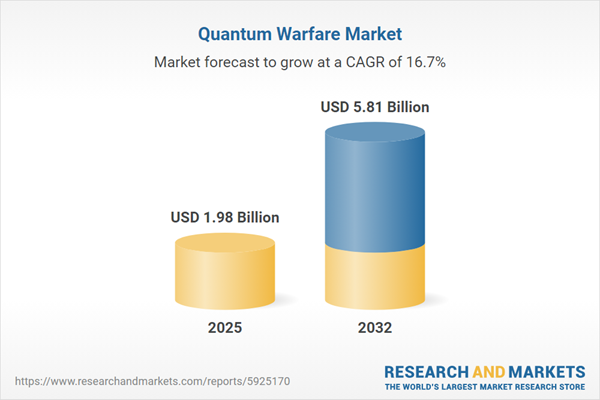Speak directly to the analyst to clarify any post sales queries you may have.
The quantum warfare market is redefining defense strategies by delivering advanced secure communications, next-generation threat detection, and rapid decision-making capabilities. As quantum technologies quickly transition from research to practical deployment, senior leaders are seeking clear, actionable intelligence to guide investments and sustain an operational edge in this evolving sector.
Quantum Warfare Market Snapshot
The global quantum warfare market is expanding steadily, fueled by increased investments from government bodies and private stakeholders focused on cutting-edge military innovation. This momentum highlights the urgent demand for resilient data protection and reliable intelligence tools, particularly as ongoing advances in quantum science enable rapid movement from theory to application. Evolving regulatory conditions are encouraging swift innovation, while deeper cooperation between sectors continues to drive essential breakthroughs in technology. Across the landscape, defense organizations are focusing on agility and quantum-enabled solutions to stay ahead in complex, fast-changing threat environments.
Scope & Segmentation of the Quantum Warfare Market
This market intelligence report offers senior decision-makers a comprehensive assessment of key quantum warfare industry segments and their strategic value in procurement and planning:
- Services: Strategic consulting streamlines the adoption of quantum technologies across defense entities. Integration services facilitate the deployment of new capabilities, and technical support combined with dedicated system maintenance ensures long-term system integrity and mission assurance.
- Hardware: The hardware segment encompasses essential infrastructure including quantum repeaters, switches, and transceivers. Technologies based on photonic qubits, superconducting circuits, and trapped-ion configurations enhance intelligence operations and tactical responses in defense applications.
- Software: This segment features advanced calibration algorithms, error correction tools, pulse orchestration platforms, and robust military-grade encryption. Each element is vital for enabling secure data handling and maintaining operational integrity within defense systems.
- Regional Coverage: Analysis spans adoption trends and technology innovation across the Americas, Europe, Middle East & Africa, and Asia-Pacific. It explores how regional partnerships and differing regulatory frameworks shape investment strategies and the pace of quantum technology rollout in military environments.
- Company Analysis: Leading market participants, including International Business Machines Corporation, Amazon Web Services, Microsoft Corporation, Google LLC, Alibaba Group Holding, Quantinuum Limited, D-Wave Systems, IonQ, Rigetti Computing, and Xanadu Quantum Technologies, are profiled for their impact and roles in shaping the competitive landscape.
Key Takeaways for Senior Decision-Makers
- Embedding quantum-safe security protocols in daily operations allows defense organizations to anticipate and mitigate emerging digital threats.
- The adoption of advanced detection and command platforms is streamlining decision-making and accelerating threat response in increasingly complex and interconnected operations.
- Collaboration across government, industry, and academic institutions is reducing development timelines, moving quantum capabilities faster from research to deployment.
- Implementing quantum-secure communications bolsters command confidence and ensures secure interoperability in international and joint mission settings.
- Procurement strategies are shifting to include quantum-resistant cryptography, enabling improved risk management, stable supply channels, and enhanced logistical resilience.
- Focused skills development ensures operational teams can effectively use and optimize new quantum systems, maintaining high standards of readiness and technological efficacy.
Tariff Impact on Supply Chains and Defense Posture
New United States tariffs on quantum technology hardware are prompting organizations to adjust their supply chain strategies. Defense agencies are turning to domestic manufacturing, broadening supplier networks, and prioritizing superconducting and photonic channels to diversify and safeguard procurement. These measures support local collaboration, enhance risk mitigation, and limit the impact of international supply disruptions to bolster the long-term dependability of vital quantum assets.
Methodology & Data Sources
This report draws on direct interviews with senior defense leaders and quantum specialists, examination of leading patent filings, and review of both public and academic research. Scenario-based modeling ensures recommendations align with current operational needs and anticipated market trajectories.
Why This Report Matters
- Supports the strategic alignment of quantum initiatives to meet evolving mission demands and future defense objectives.
- Enables adaptive procurement, helping organizations manage disruptive risk arising from shifting supply chains and regulatory landscapes.
- Identifies actionable opportunities for partnerships, targeted investment, and ongoing improvements in quantum-driven defense environments, enhancing overall mission effectiveness.
Conclusion
This executive report delivers critical insights for integrating quantum technologies, strengthening defense readiness, and advancing organizational capabilities within today's rapidly shifting security landscape.
Additional Product Information:
- Purchase of this report includes 1 year online access with quarterly updates.
- This report can be updated on request. Please contact our Customer Experience team using the Ask a Question widget on our website.
Table of Contents
3. Executive Summary
4. Market Overview
7. Cumulative Impact of Artificial Intelligence 2025
Companies Mentioned
The companies profiled in this Quantum Warfare market report include:- International Business Machines Corporation
- Amazon Web Services, Inc.
- Microsoft Corporation
- Google LLC
- Alibaba Group Holding Limited
- Quantinuum Limited
- D-Wave Systems Inc.
- IonQ, Inc.
- Rigetti Computing, Inc.
- Xanadu Quantum Technologies Inc.
Table Information
| Report Attribute | Details |
|---|---|
| No. of Pages | 184 |
| Published | October 2025 |
| Forecast Period | 2025 - 2032 |
| Estimated Market Value ( USD | $ 1.98 Billion |
| Forecasted Market Value ( USD | $ 5.81 Billion |
| Compound Annual Growth Rate | 16.6% |
| Regions Covered | Global |
| No. of Companies Mentioned | 11 |









